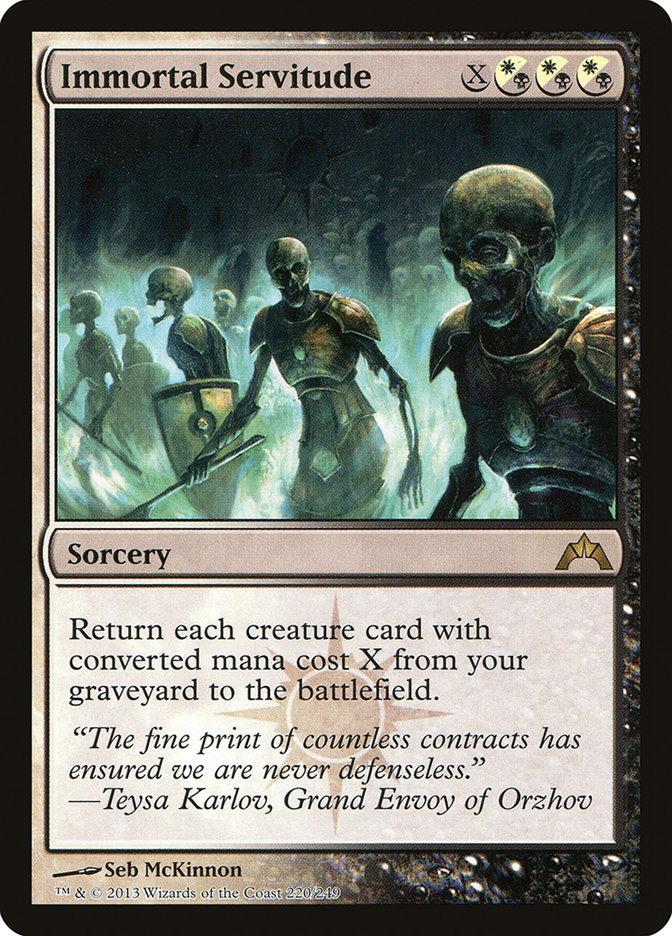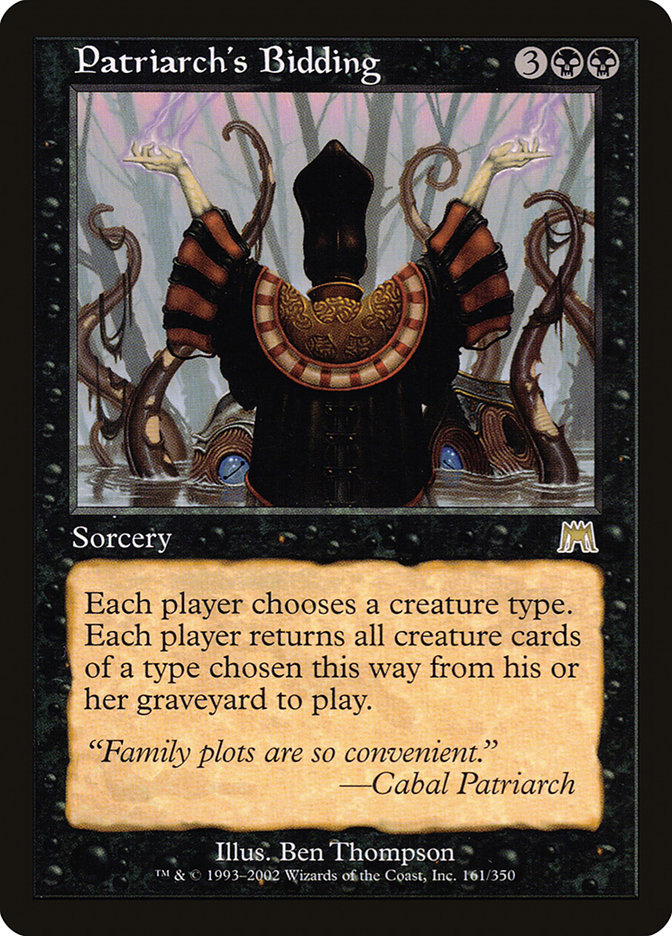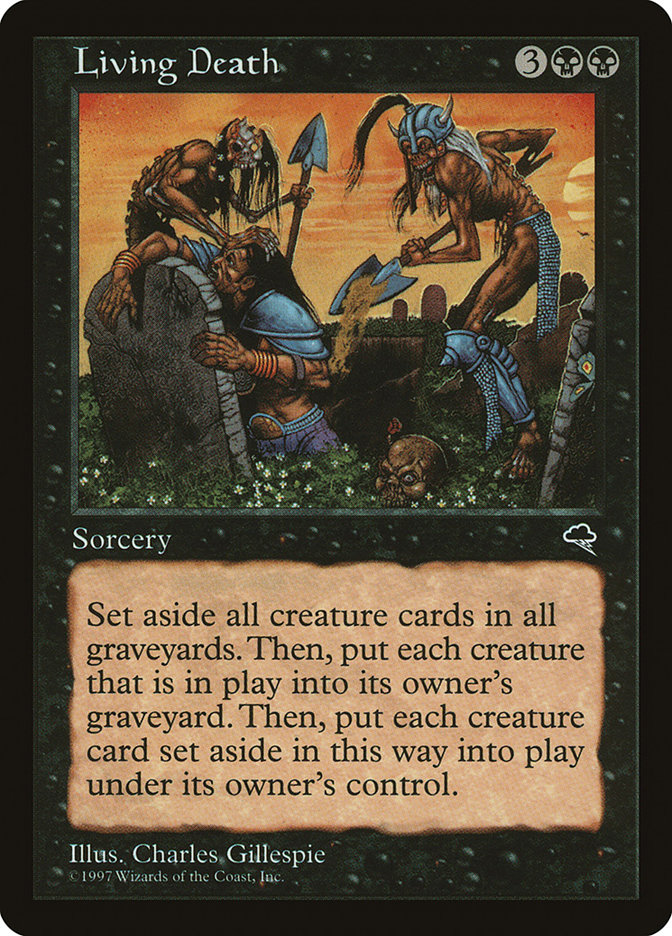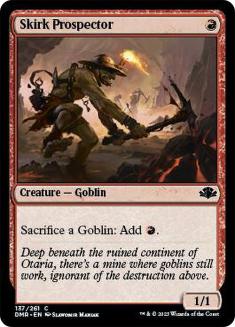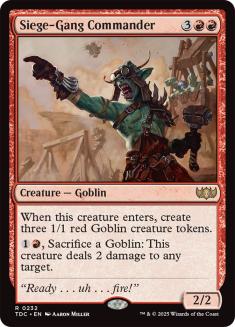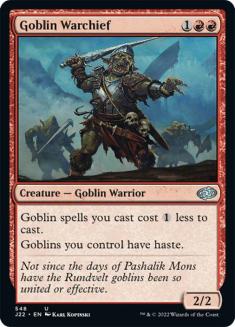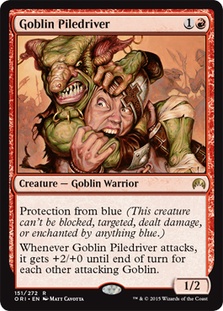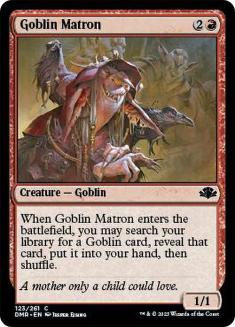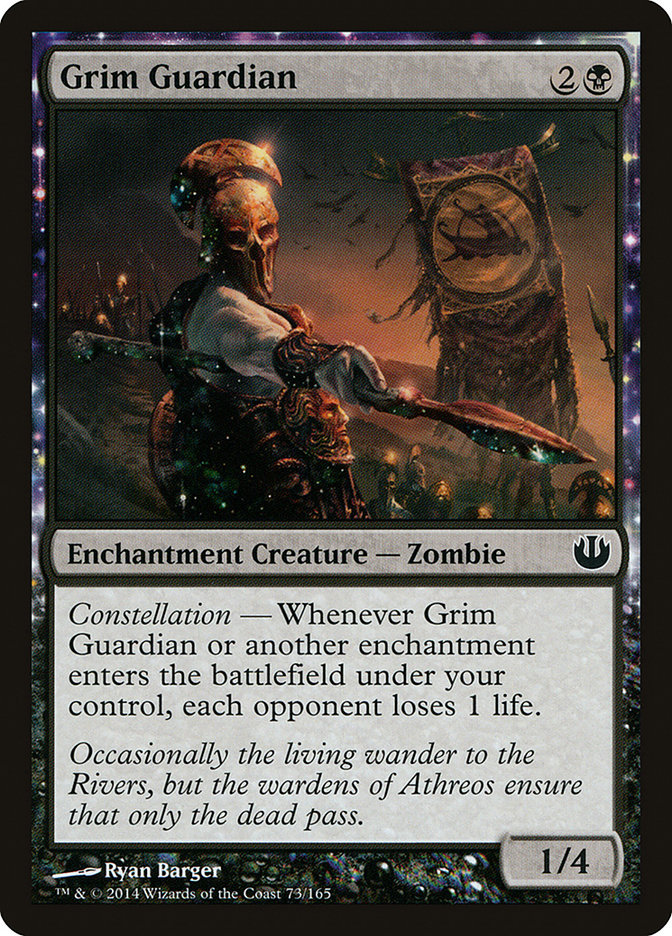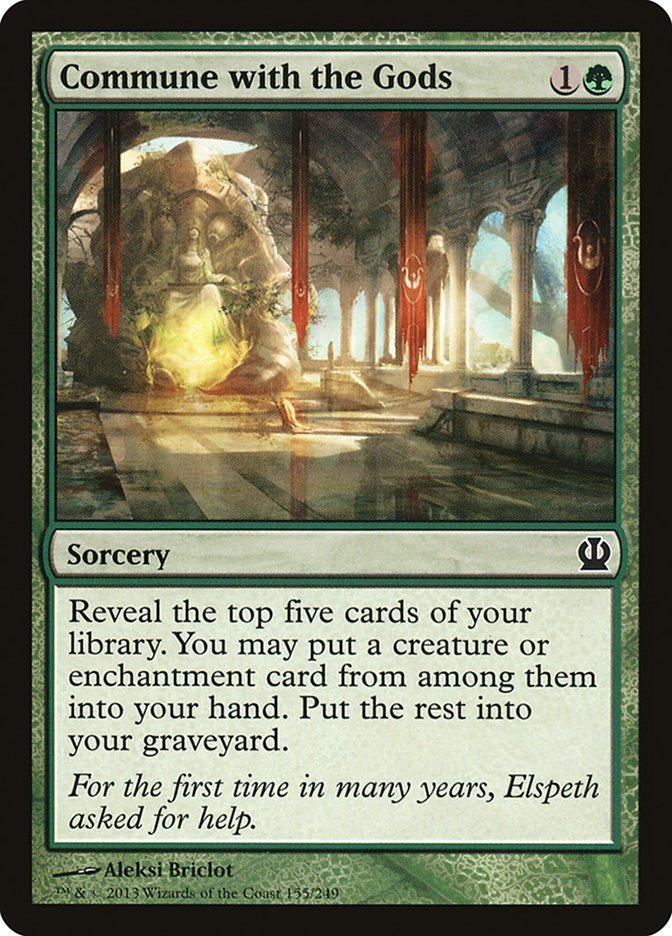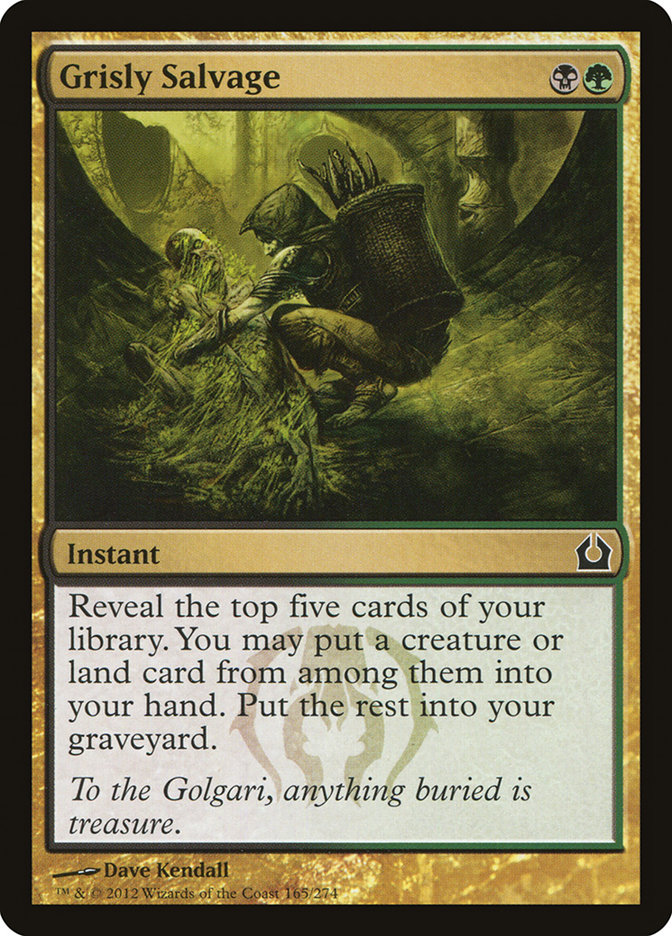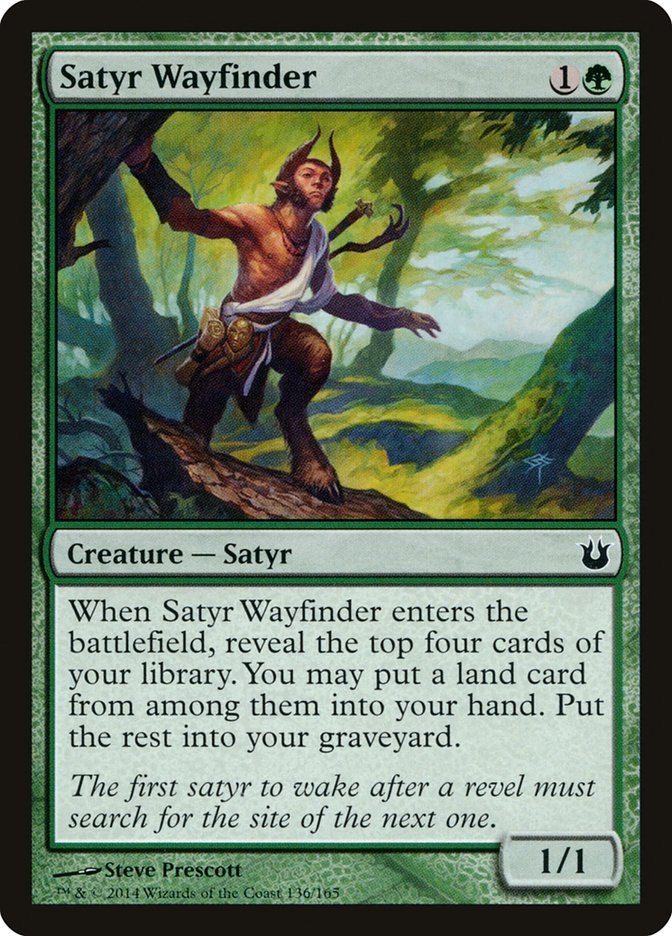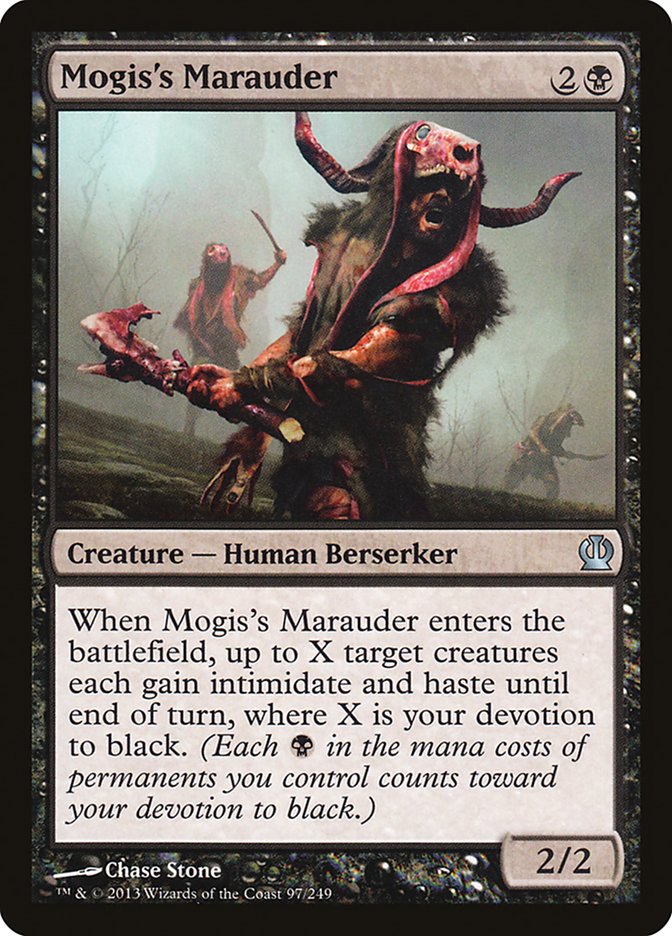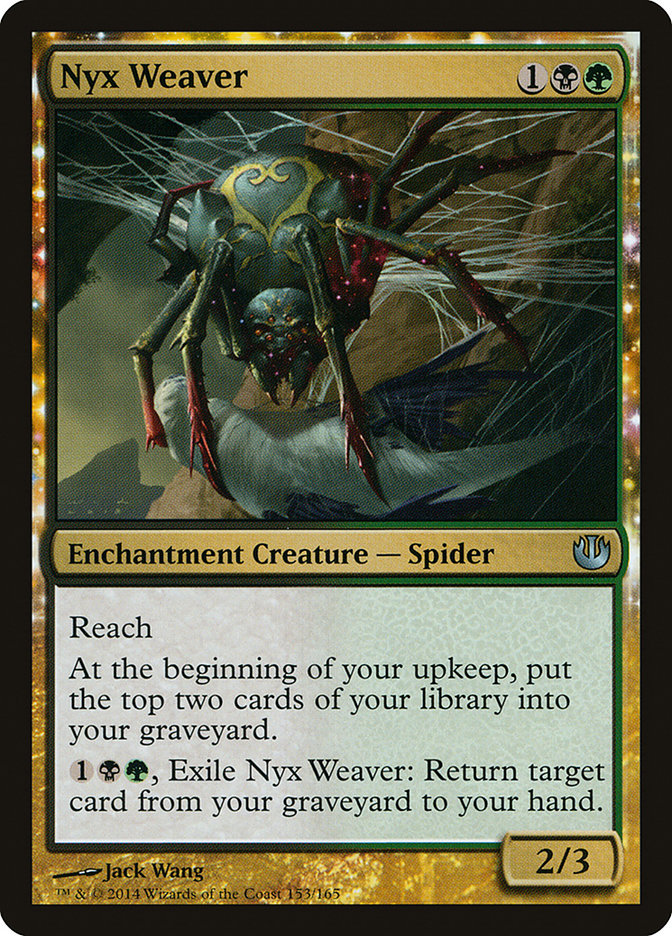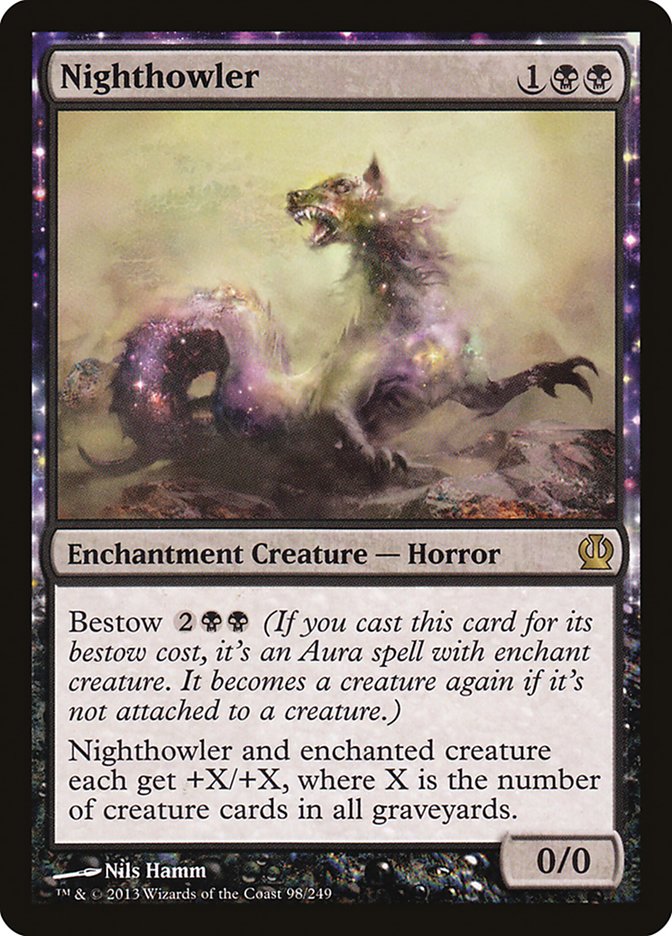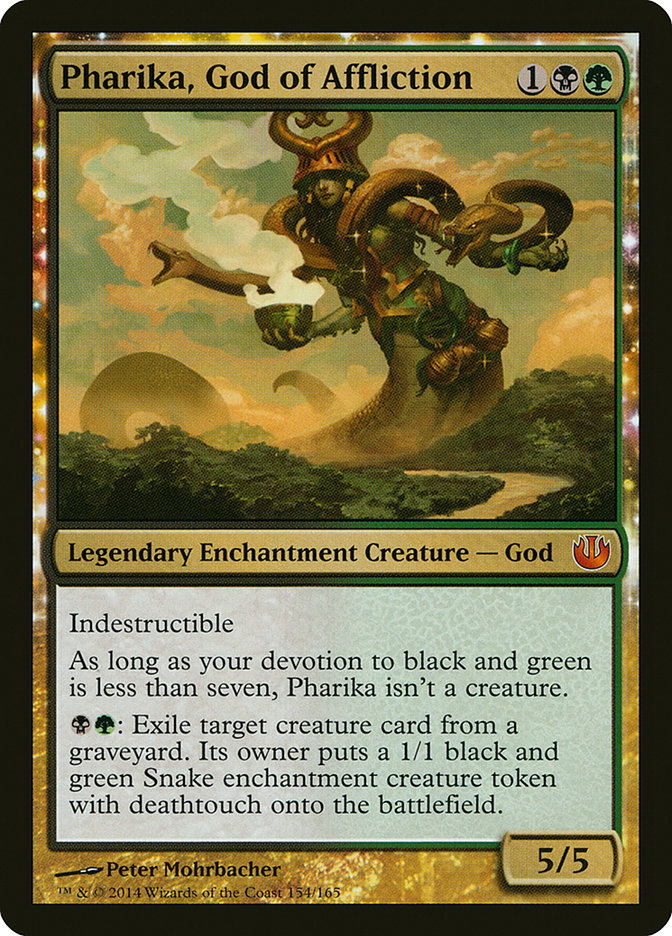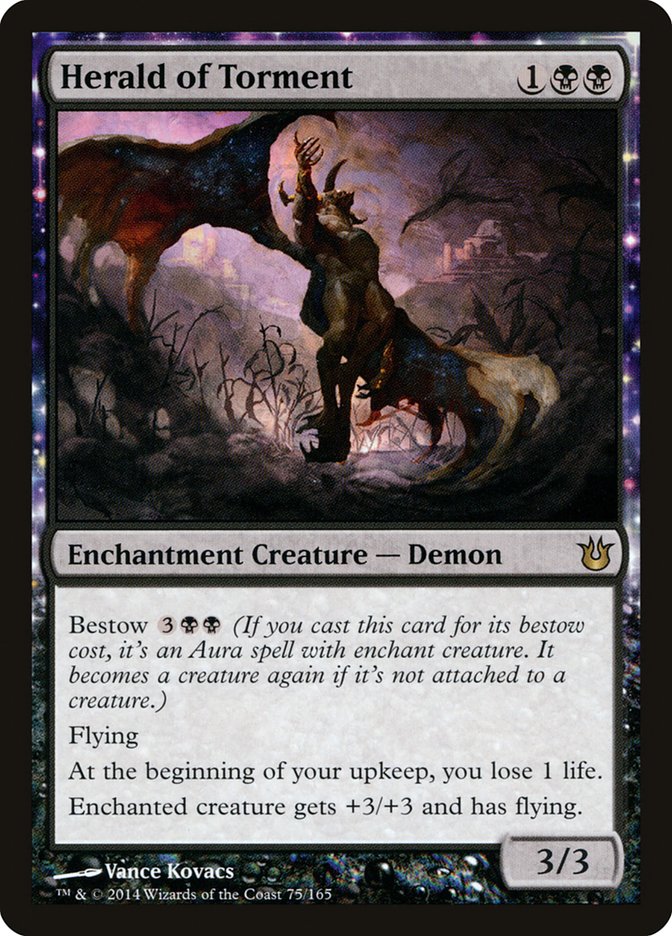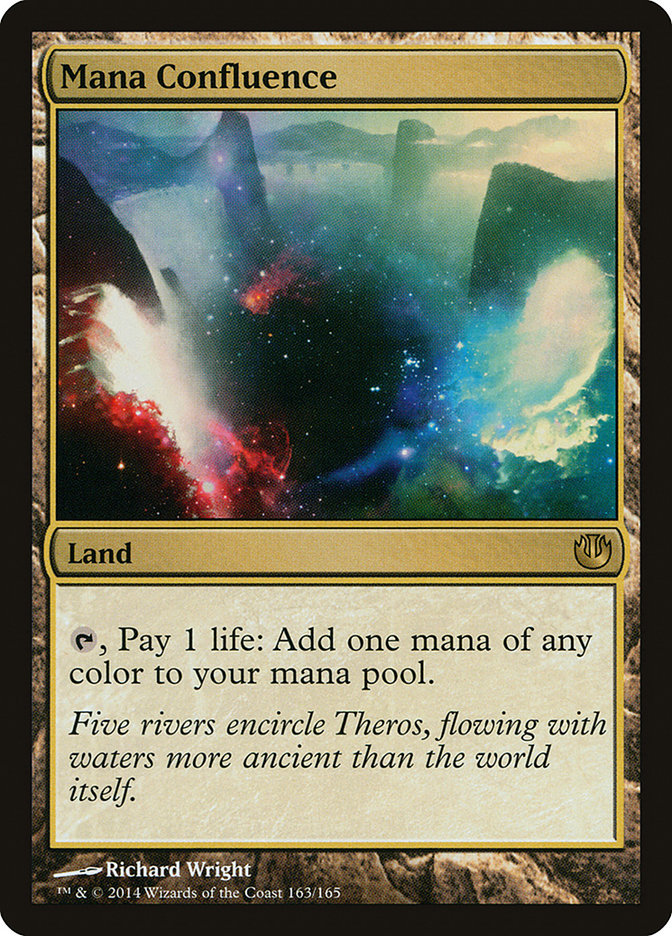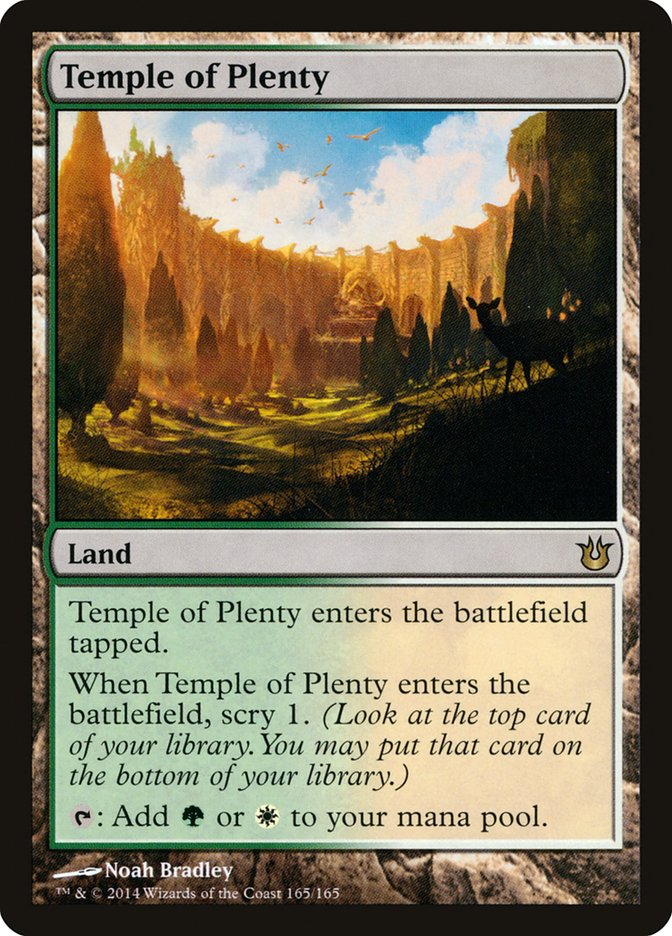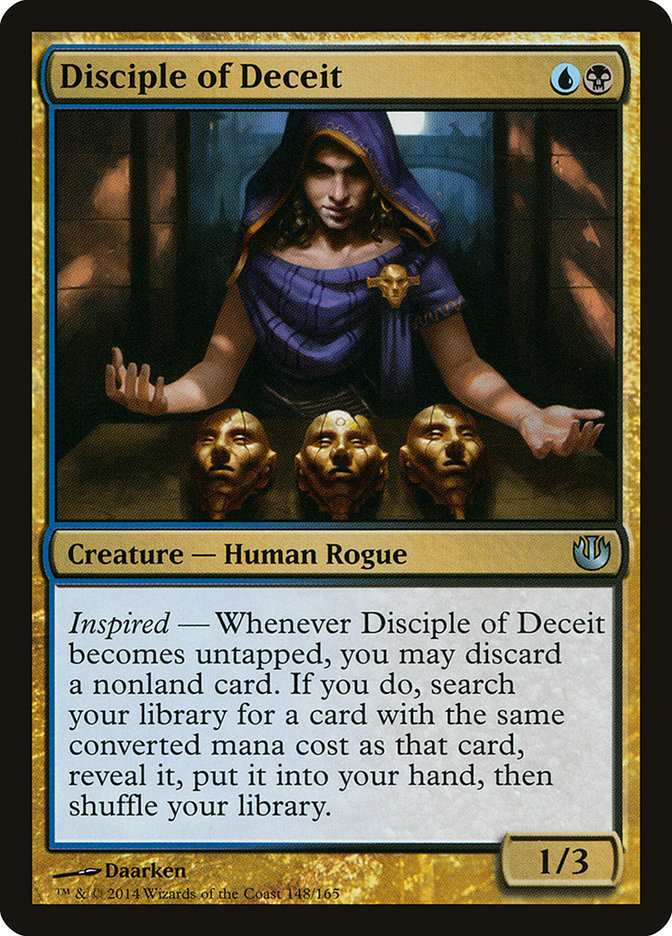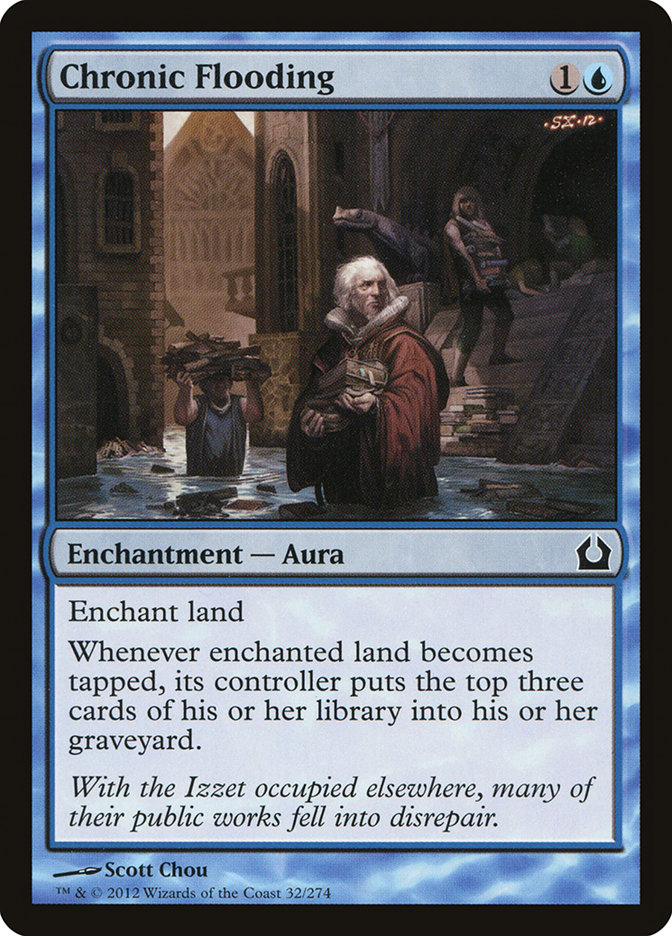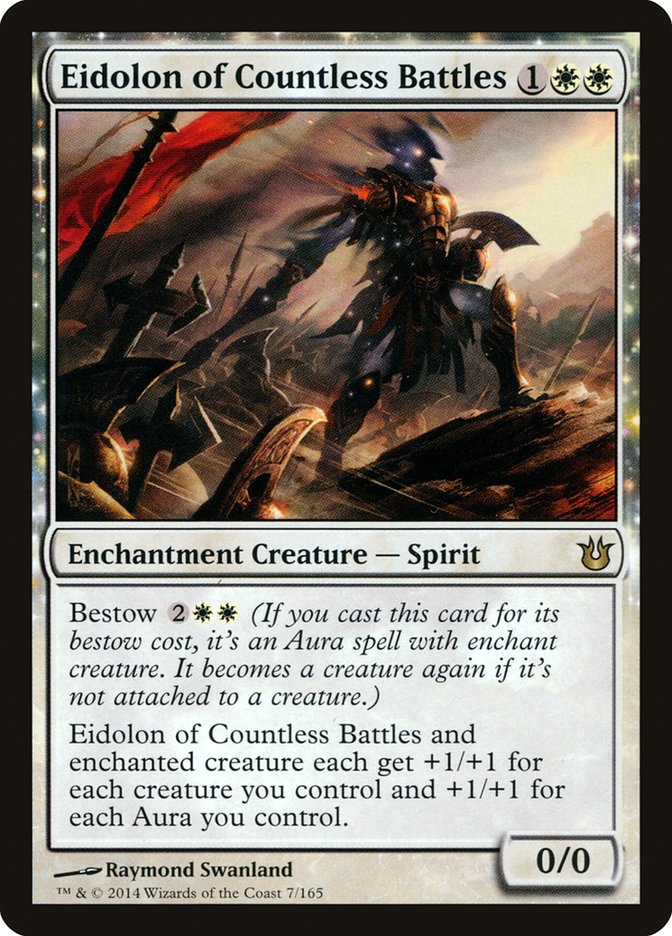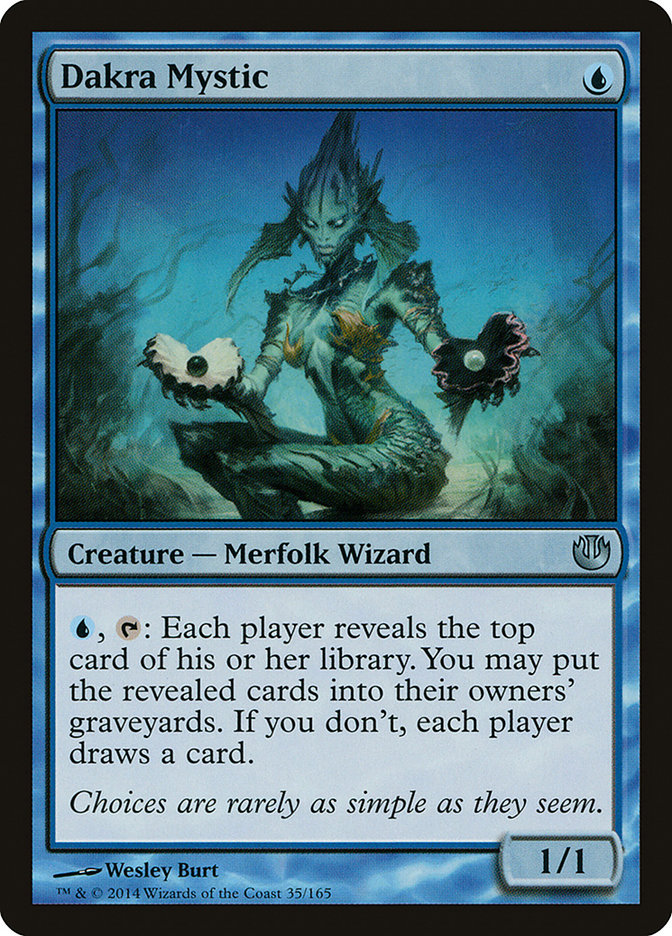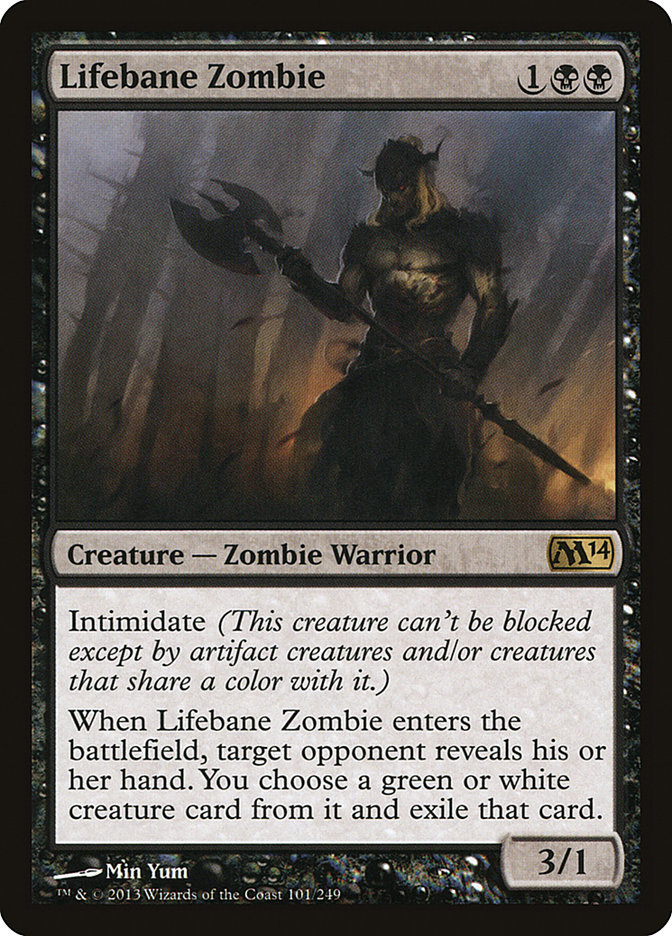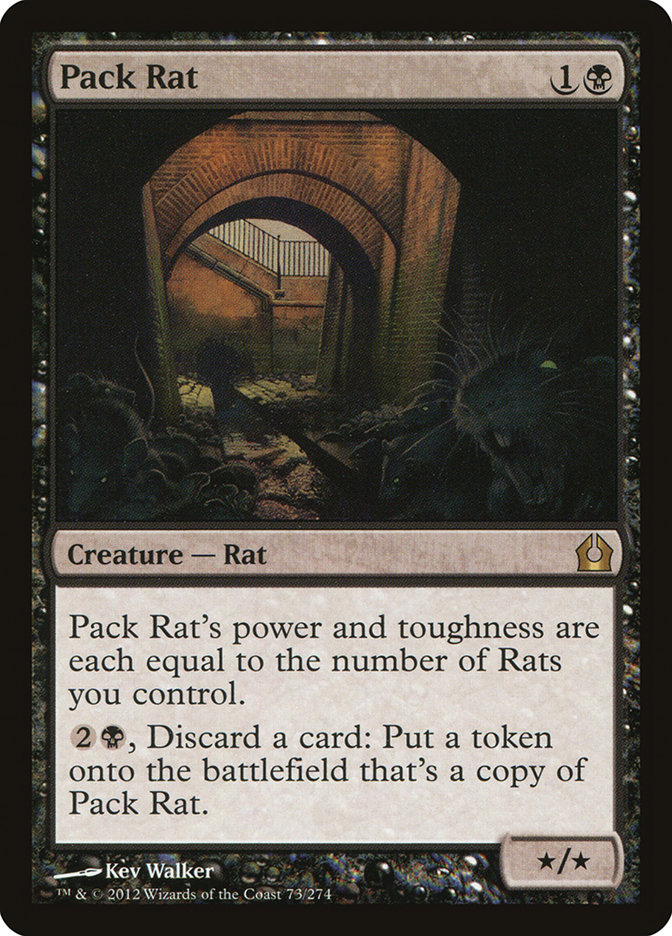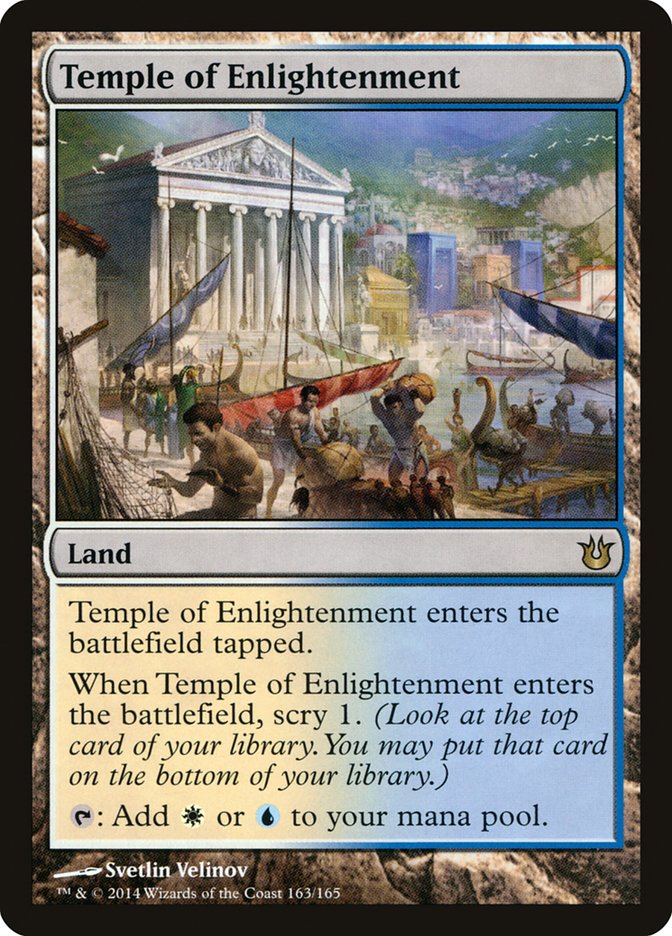So I was looking over the Gatecrash spoiler, and man am I super excited!
Wait—what’s that you say?
Gatecrash came out over a year ago?
Journey into Nyx is the brand-new set coming out this Friday?
Oh . . .
But this card looks super sweet!
Well, I guess we can time machine back (forward?) to 2014 and see what we can do with it.
One of the best parts about when a new set comes out is not just the awesome new cards that it brings but also the role players it can have for awesome old cards that never had a chance to shine. Immortal Servitude is a powerful but narrow effect that never really got off the ground because of the difficulty in assembling enough good combo pieces with only a few sets.
Journey into Nyx brings us a number of new pieces to our immortal puzzle.
So what is our goal?
While cards like Patriarch’s Bidding and Living Death have been used fairly before, the usual goal is to bring back enough creatures to win the game on the spot.
A deck like Goblin Bidding brought back a ton of Goblins, gave them all haste, and then made a bunch of mana with Skirk Prospector and almost always won the game on the spot.
So what does Journey into Nyx give us?
What, did you look over this card when you were reading the spoiler? How could you deny the awesome power that is Grim Guardian?
By itself Grim Guardian is the quintessential nickel and dime Limited card. It’s going to make some blocks, drain a few points of life, and hopefully provide enough of an advantage to win a long drawn-out game.
But we’re not looking to trigger it just a few times; we’re looking to trigger a few of them a whole bunch of times, preferably all at the same time.
Creatures (28)
- 4 Elvish Mystic
- 4 Nighthowler
- 2 Mogis's Marauder
- 2 Herald of Torment
- 3 Courser of Kruphix
- 3 Satyr Wayfinder
- 2 Pharika, God of Affliction
- 4 Nyx Weaver
- 4 Grim Guardian
Lands (17)
Spells (15)

Following the same basic shell of G/B Dredge, we are also looking to fill up our graveyard with all sorts of stuff. But instead of just making some big Nemesis of Mortals and Nighthowlers, we have bigger plans that can’t be foiled by a few removal spells. Let’s break it down.
The core engine of the deck is exactly the same as the G/B Dredge deck since our initial goal is very similar—fill up our graveyard. All of these cards help do this while providing some value, and Grisly Salvage and Satyr Wayfinder allow us to cheat on lands a bit despite the fact that we’re looking to cast a six-mana spell.
Immortal Servitude is the backbone of the deck, and in concert with Grim Guardian and Mogis’s Marauder it forms the basis of our combo kill.
Every single creature in the deck that costs three mana (with the exception of Mogis’s Marauder) is an enchantment creature and will trigger Grim Guardian. This means that if you cast an Immortal Servitude and bring back two Grim Guardians and six other creatures, you will get sixteen unstoppable triggers to drain your opponent’s life away in addition to the army you just created.
While sometimes you’re just going to bring back three Grim Guardians and kill your opponent on the spot, Mogis’s Marauder provides you with the extra power needed to end the game the same turn you cast Immortal Servitude. Mogis’s Marauder’s ability not only gives intimidate but also haste, and because there are plenty of black symbols on all of your creatures, you can immediately attack them for the remaining damage if need be.
While not that impressive, both creatures are also very castable if need be and can play some reasonable offense and defense.
While the deck is focused on the combo, it is not completely reliant on it. Another unassuming but powerful new card in the deck is Nyx Weaver. While Nyx Weaver has the somewhat obvious application of slowly filling up our graveyard, it has a lot of subtle features that make it a very real card. Its 2/3 reach body does a fantastic job at playing defense, stopping everything from an army of two-drops to the ever present Nightveil Specter. It can also chump block a Stormbreath Dragon for a turn if you need one more turn to attack for the win post-Servitude. While its regrowth effect very slow to just use for value, it is actually a great tutor for an Immortal Servitude that was lost to the graveyard. Lastly, it is also an enchantment for Grim Guardian and a black creature for Mogis’s Marauder.
Nighthowler has more than proved its worth in the G/B Dredge deck and provides us with an aggressive angle to pressure the opponent with while we dig for our combo. While Nighthowler will shrink when it returns to play off of an Immortal Servitude, it will still trigger Grim Guardian and provide a few points of attack power for Mogis’s Marauder.
More interesting is the use of the much maligned Pharika, God of Affliction. Pharika does a number of good things for the deck. She is a three-mana enchantment creature, which means she will come back off of Immortal Servitude, and her ability can help to close out the game by triggering constellation. Considering that she will be coming back with a bunch of other creatures, it is extremely likely she will be a creature and a candidate to attack alongside Mogis’s Marauder, which provides you with a lot of extra attack power.
Rounding out the deck is a pair of proven enchantment creatures. Herald of Torment is a strong attacker that can send a Nighthowler to the skies for a surprise attack and provide two devotion for a huge Mogis’s Marauder attack. While the deck is a little light on lands, Courser of Kruphix is a great defensive creature and just fits the bill as a three-mana enchantment creature.
A couple of Mana Confluence help ensure you have the early mana you need, especially for a turn 1 Elvish Mystic, while a pair of Temple of Plenty gives you some extra scry and helps with the somewhat prohibitive mana cost of Immortal Servitude.
So why play this over G/B Dredge? While G/B Dredge is sweet, it is susceptible to the myriad of removal spells in the format. If your creature is dead, it doesn’t really matter if it was a 10/10 or a 3/3. The combo kill can only be stopped by counterspells, and hopefully we can just grind out the control decks with our creatures.
While the B/G Servitude deck is based on an already proven shell, let’s see what else we can come up with. One card that excites me is Disciple of Deceit.
Disciple of Deceit can help set up an Immortal Servitude combo all by itself by discarding three-mana creature after three-mana creature and then eventually tutoring up Immortal Servitude to go for the kill.
Creatures (26)
- 1 Pack Rat
- 4 Deathrite Shaman
- 2 Lifebane Zombie
- 4 Nighthowler
- 4 Mogis's Marauder
- 2 Herald of Torment
- 3 Eidolon of Countless Battles
- 2 Dakra Mystic
- 4 Disciple of Deceit
Lands (18)
Spells (16)

This deck is definitely a bit more wacky and unrefined, so let’s break it down.
As we talked about, Disciple of Deceit does a lot of heavy lifting in this deck, providing you both with a discard outlet and a tutor effect for three-mana creatures and Immortal Servitude. Its 1/3 body is durable enough to enter combat a few times to trigger inspired, and you can also use Springleaf Drum for a mana boost and combat-less inspired triggers. Disciple even lets you play a small toolbox of two- and-three mana spells that can be helpful at different times.
Chronic Flooding is the main reason that the deck even exists and has already proven itself as a fantastic way to fill up your graveyard quickly and consistently. Requiring no further mana investment, Chronic Flooding is an excellent source of inevitability.
Breaking // Entering is essentially a poor man’s Glimpse the Unthinkable, but binning eight cards in one quick two-mana shot with Breaking is pretty good, You also have the backdoor chance of casting Entering off of a Deathrite Shaman or Mana Confluence.
This deck features a very similar kill to the last deck—cast Immortal Servitude for three and win the game—but goes about it in a slightly different way. This deck is all in on Mogis’s Marauder and includes three Eidolon of Countless Battles as a huge three-mana creature to bring back and give haste for the kill. Alongside all of your other creatures, Eidolon should be more than lethal. The only downside to this kill is that against mono-black decks your creatures won’t be unblockable, but in that scenario the sheer number of creatures returning should be more than enough to win the game.
Nighthowler again makes an appearance as your plan B is for beatdown and should be just as large in this deck as the first one. It will also provide you with the needed devotion for your Mogis’s Marauder turns and still be a reasonable size due to the other creatures in the deck that don’t cost three.
Dakra Mystic makes its debut in this deck as a graveyard-filling card-drawing machine. As a cheap creature, it can help you draw into your combo pieces, and whenever you hit a card you’d rather have in the graveyard, you can just put it there with no downside. One of the benefits of the combo kill is that you don’t really care how many cards your opponent has as long as they’re dead, and I’m excited to see what Dakra Mystic can do.
Rounding out the utility section of the deck is the ubiquitous Deathrite Shaman. Not nearly the force in Standard as it is in formats with fetch lands, the Shaman will have plenty of lands to munch on in this deck and provide you with a very nice mana boost as well as some life drain for the last few points of damage if need be.
The deck is rounded out with a smattering of creatures that can either come back for a big Servitude turn or just be tutored up with Disciple of Deceit. These are of course interchangeable depending on how the format shapes up.
This deck has a similar mana base to the B/G deck, with some Mana Confluence for early colored mana and a few white Temples for some extra scry and to help cast Immortal Servitude off of blue sources. Both also give you backdoor ways to cast Eidolon of Countless Battles and Entering, which is a nice bonus.
Both of these decks are pretty rough but provide exciting possibilities for the new format. Standard hasn’t really seen a true combo deck in a while, and whenever a good one shows up, it usually is able to take the entire format by storm.
They say you can’t teach an old dog new tricks, but I beg to differ.

